Bulletin – October 2002 The Changing Composition of the Australian Workforce[1]
- Download 62KB
The unemployment rate in Australia has declined over the past decade to be currently just over 6 per cent, close to the bottom end of the range in which it has varied during the past two decades. While the unemployment rate is close to the rate that prevailed in 1980, there have been marked changes in labour force participation and in the composition of the workforce in the intervening period. This article provides an overview of these changes by examining trends in employment to population ratios of different parts of the working age population. The most notable changes over the past two decades have been a rise in the aggregate employment to population ratio along with a rising share of part-time work and rising female participation in the labour force.
Graph 1 plots the share of the working age population (those between 15 and 64 years old) that is employed. It illustrates the upward trend in this ratio in Australia over the past two decades, after it had declined markedly through the second half of the 1970s. A similar upward trend over the past 20 years has occurred in the US, Canada, the UK and New Zealand. In contrast, the ratio has been broadly flat over this period in Japan and France. At just under 70 per cent, the employment to population ratio in Australia is comparable to that in Canada and Japan, below that in the UK, New Zealand and the US, but noticeably higher than in France and Germany.
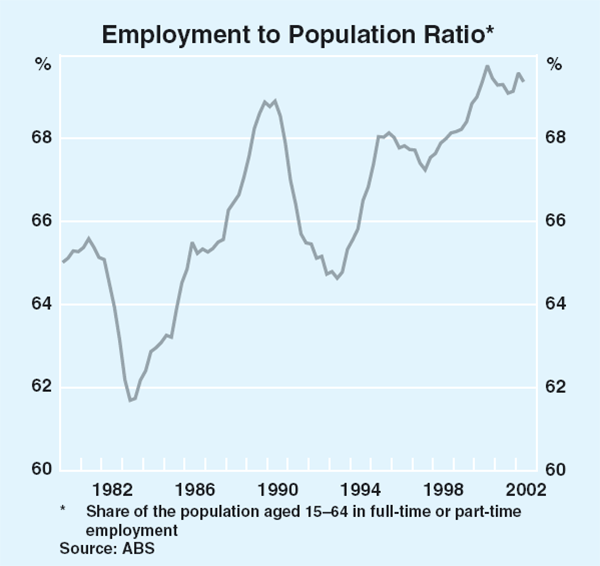
The upward trend in the aggregate employment to population ratio masks quite divergent trends in the ratios for males and females and for those in full-time and part-time work. In general, full-time employment to population ratios are much higher for males than for females. Graph 2 also shows that the full-time employment to population ratio of males has decreased over the past two decades – particularly in recessions – but it has risen for females. On the other hand, Graph 3 illustrates that part-time employment to population ratios have risen significantly for both males and females.
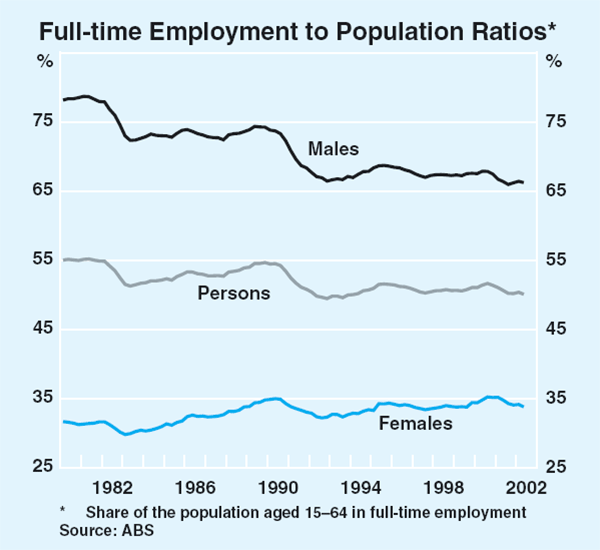
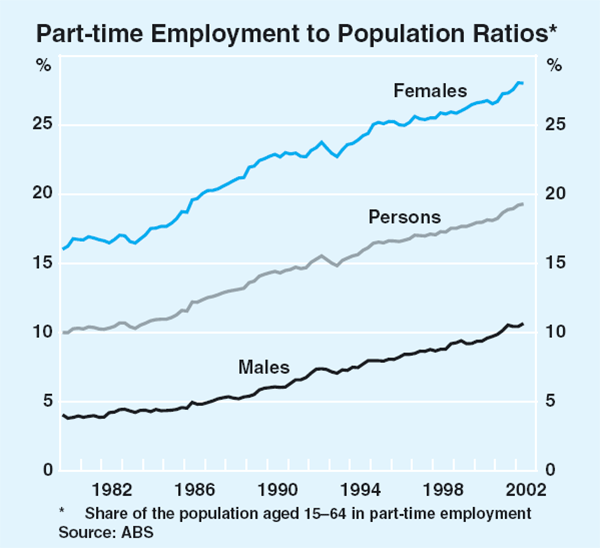
These outcomes reflect a number of different developments that have affected the supply of and demand for labour over the past two decades. The developments can be broadly grouped into the following three categories:
- A structural effect: Employment to population ratios have been affected by structural factors that have changed labour supply and labour demand decisions over time, such as greater access to childcare, improved educational arrangements, and increased social acceptance of women in the workplace.
- A cohort effect: At different stages of their working life, people have varying degrees of attachment to the labour force. For example, younger workers tend to have weaker attachment to the workforce, in part reflecting their high level of participation in education. Prime-age workers have a much stronger attachment to the labour force. Hence, employment to population ratios can vary across age-group cohorts, so that changes in the demographic composition of the population can affect the broader aggregates. In addition, the tendencies of different cohorts to participate in the labour market can change in response to changing economic conditions.
- A cyclical effect: The business cycle can influence employment to population ratios, as is evident in Graphs 1, 2 and 3. The effect of the business cycle on the employment share can differ across gender and age cohorts, in part reflecting the fact that industries which are more cyclically sensitive have tended to employ relatively larger shares of male full-time prime-age workers. The influence of the business cycle can also vary because the labour supply of some demographic groups can be more cyclically sensitive than others.
Graphs 4, 5 and 6 illustrate the combined influence of these three effects on the employment to population ratios of males and females of different ages. The cohort effect influences the general shape of each curve, and, for example, is reflected in the tendency for prime-age workers to have higher employment shares than older and younger workers. Structural changes in the labour market predominantly determine the movements up and down in the curves through time, of which an important example is the large increase in the employment share of females. In principle, the shifts in the curves can also reflect differences in the state of the business cycle although, as noted above, the unemployment rates were similar in the two years chosen for the comparison. The remainder of this article examines these trends in the employment shares of different age and gender groups in more detail.
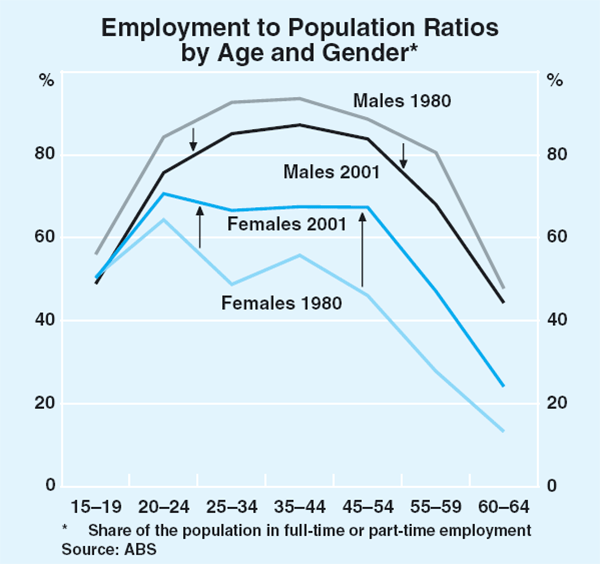
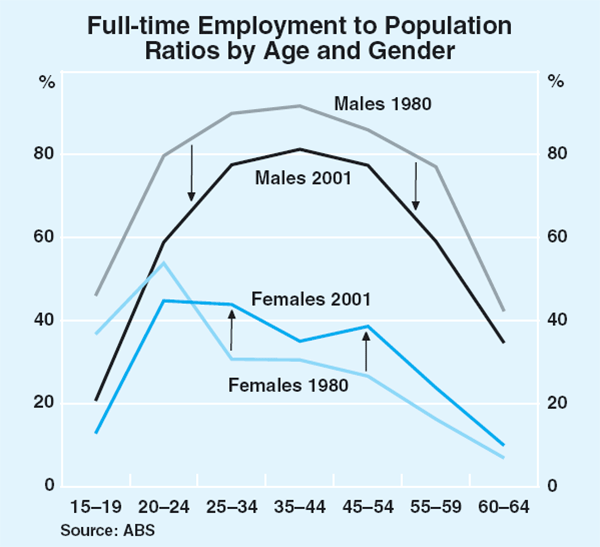
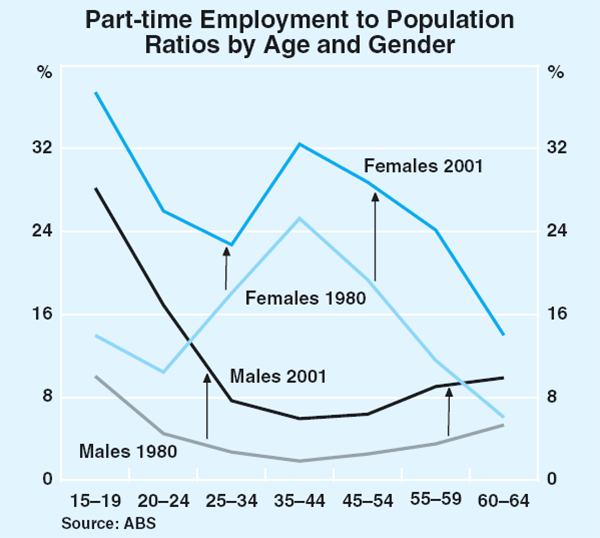
Persons Aged 15–24
Prior to the 1980s, both males and females in the 15–24 cohort were more likely to be in full-time employment than in part-time employment. However, rising secondary education retention rates and increased participation in tertiary education, together with the increase in demand for part-time workers in the 1980s, saw part-time employment to population ratios for younger workers increase noticeably in both the 1980s and 1990s. The part-time employment share of males aged 15–24 rose from 7 per cent in 1980 to 22 per cent in 2001 while for females it rose from 12 per cent to 31 per cent. Increased participation in education contributed to a fall in the full-time employment share for males and females. In aggregate, however, the employment share of females in this age cohort has risen to be only slightly lower than that for males.
The employment shares of the 15–24 cohort appear to have been the most affected by the business cycle over the past 20 years. The full-time employment to population ratio of the group dropped substantially in the early 1980s, and again in the early 1990s. Those between the ages of 15 and 19 were most affected, in part reflecting the alternative of remaining in secondary education. By contrast, the part-time employment to population ratio does not appear to have been significantly affected by either recession.
Persons Aged 25–54
This demographic group represents the prime working age for both males and females. Employment to population ratios are much lower for females than for males, primarily because women generally have more responsibility for child-rearing. Over the past two decades, however, changes such as increased acceptance of women in work and greater participation of females in education have significantly altered the labour supply decisions of this cohort (although these effects have been at work over a much longer period of time). This is evident in the narrowing of the gap over the past two decades between male and female employment to population ratios for this cohort.
After rising sharply in the 1980s from 30 per cent to 37 per cent, the full-time employment to population ratio for prime-age females has risen less rapidly subsequently, and has levelled out at just under 40 per cent recently. Since 1980, the part-time employment share has risen by an even greater amount than the full-time share, reflecting the combination of an increase in demand for part-time workers, as well as the willingness of those with family responsibilities to take advantage of the extra flexibility part-time work provides. It has continued to rise in recent years.
The share of prime-age males in full-time employment has declined by around 10 percentage points over the past two decades. Most of this fall occurred in two episodes following the recessions of the early 1980s and 1990s, partly reflecting the high share of prime-age male full-time workers in cyclically sensitive industries such as construction and manufacturing. The longer-term decline in the share of prime-age males employed full-time has similarly been associated with a declining share of the manufacturing sector in the economy over the past two decades. In contrast to the fall in the male full-time employment to population ratio, the part-time employment to population ratio for males in this cohort increased rapidly during the early 1990s and has continued to increase in recent years.
Persons Aged over 55
The fall in the employment to population ratios for those aged 55–64 years in the paid workforce demonstrates the increased take-up of early retirement, whether voluntary or involuntary, for this age cohort. For both males and females, part-time employment to population ratios increased substantially in the 1990s, suggesting that part-time employment is becoming an increasingly attractive alternative to early retirement.
Furthermore, as this age cohort has the option of early retirement, we would expect them to be more responsive to the business cycle. This has been particularly true of males over the age of 55 in the past two decades, where a substantial decline in the full-time employment share following both recessions is evident. While the employment to population ratio for males has been roughly steady between these episodes, the female full-time employment to population ratio for this age group was roughly flat over the 1980s and experienced a noticeable increase over the 1990s, a trend which has continued over the past two years. This represents a continuation of the large increases in the full- and part-time employment to population ratio of the prime working age cohort in the 1980s, as these workers have moved into higher age brackets and have maintained their increased attachment to the labour force.
Conclusion
The changing demographic and economic structure of Australia has substantially altered the composition of the workforce over the past two decades. There has been a large increase in the share of females in the workforce and in the share of part-time relative to full-time employment reflecting, inter alia, changes in the industrial structure of the economy as well as changes in labour supply. The strong rise in female employment has been associated with an overall increase in the employment to population ratio since 1980.
Another reason for the increase in the aggregate employment to population ratio is that the large baby-boomer cohort has been moving into the high-participation prime-age group over the past 20 years. However, this effect appears to have been relatively small. Assuming that gender-age employment to population ratios remain as they are currently, the movement of this cohort from the prime-age to the retirement-age group in the years ahead would cause the aggregate employment to population ratio to decline. However, an offsetting effect is that females in this cohort have, in aggregate, had a stronger attachment to the labour force than earlier generations, and this may translate into higher employment shares as this cohort ages.
Footnote
This article has been prepared by Sarah Babb and Natalie Parlett of Economic Analysis Department. [1]